#they’re supposed to look like Texan ranchers
Explore tagged Tumblr posts
Note
if you had to cast Jake’s parents and brothers in Like This Forever, who would you pick? Love that fic so much already 🤠🥰
Me, upon reading this ask: I am going to create a family that is SO BEAUTIFUL—
So for the parents, I’m going to go with Nancy Sinatra as Mary-Lynn Seresin, and Harrison Ford as Bill Seresin. I think Mary-Lynn for sure wears her hair just like that 🥹. They’re probably in their late fifties when the fic takes place.


And then for the Seresin boys, from left to right and in order of age we’ve got Jensen Ackles as Matthew Seresin (33), Scott Eastwood as Noah Seresin (32), and Oliver Jackson-Cohen as Daniel Seresin (31)



Then, of course, we have Jake and we’re going to pretend that this is what a twenty-six year old looks like 🫶



#I’m not putting bald Glen as a face claim and you can’t make me x#the Seresin family#faceclaims#like this forever#Jake Seresin#jake hangman seresin#they’re supposed to look like Texan ranchers#and they’re the prettiest texan ranchers I have ever seen
32 notes
·
View notes